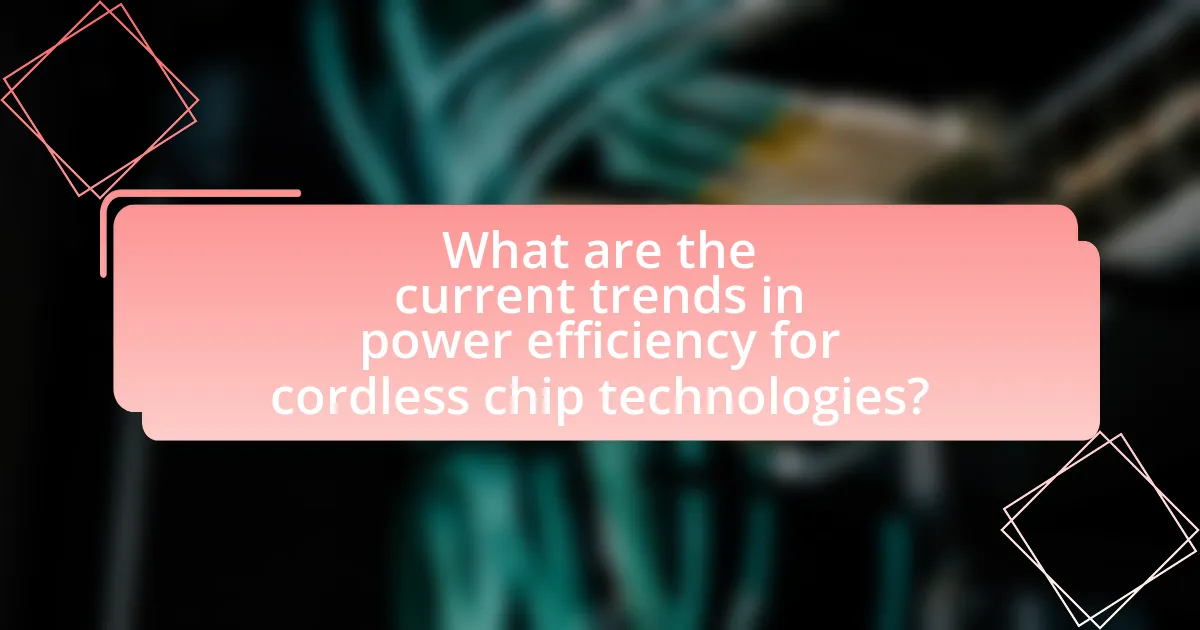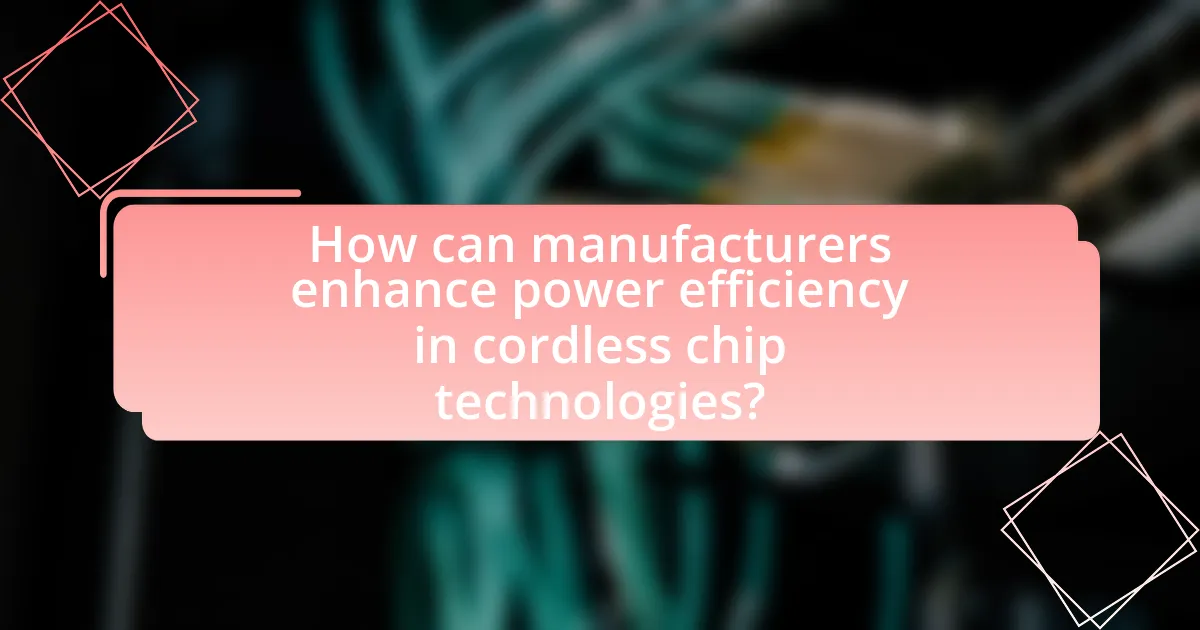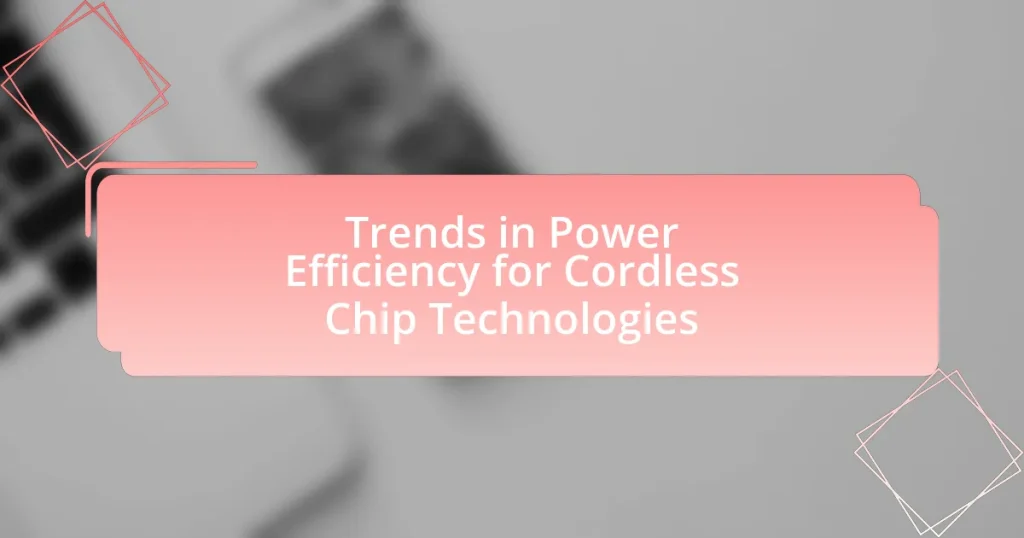The article focuses on current trends in power efficiency for cordless chip technologies, highlighting advancements in fabrication techniques, low-power semiconductor materials, and adaptive power management systems. Key metrics for measuring power efficiency, such as energy consumption per operation and battery life, are discussed alongside their impact on device performance and longevity. The article also examines the environmental implications of improved power efficiency, challenges faced in enhancing it, and the role of market factors and consumer demands in driving innovation. Additionally, it outlines best practices for manufacturers to optimize power efficiency and predicts future trends in the evolution of cordless chip technologies.

What are the current trends in power efficiency for cordless chip technologies?
Current trends in power efficiency for cordless chip technologies focus on reducing energy consumption through advanced fabrication techniques and optimized power management systems. Innovations such as the use of low-power semiconductor materials, like gallium nitride, enable chips to operate at higher efficiencies while generating less heat. Additionally, adaptive power scaling techniques allow chips to adjust their power usage based on workload demands, significantly improving overall energy efficiency. For instance, recent studies indicate that implementing these strategies can lead to power savings of up to 50% in certain applications, demonstrating a clear shift towards more sustainable and efficient cordless chip designs.
How is power efficiency measured in cordless chip technologies?
Power efficiency in cordless chip technologies is measured primarily through metrics such as energy consumption per operation, battery life, and overall system performance under varying loads. These metrics provide a quantitative assessment of how effectively a chip utilizes power while performing its functions. For instance, energy consumption is often expressed in milliwatts per operation, allowing for direct comparisons between different chip designs. Additionally, battery life is evaluated in hours of operation under specific usage scenarios, which reflects the chip’s efficiency in real-world applications. Studies have shown that advancements in low-power design techniques, such as dynamic voltage scaling and sleep modes, can significantly enhance power efficiency, leading to longer battery life and reduced energy costs in devices utilizing these technologies.
What metrics are used to evaluate power efficiency?
Metrics used to evaluate power efficiency include Energy Efficiency Ratio (EER), Power Usage Effectiveness (PUE), and Energy Star ratings. EER measures the output of cooling or heating in relation to energy consumed, providing a clear indication of efficiency in HVAC systems. PUE, commonly used in data centers, assesses the ratio of total building energy usage to the energy used by the IT equipment alone, highlighting the efficiency of energy use in computing environments. Energy Star ratings, established by the U.S. Environmental Protection Agency, provide a standardized measure of energy efficiency for various products, indicating how well they perform relative to their energy consumption. These metrics are essential for assessing and improving power efficiency in technologies, particularly in the context of cordless chip technologies.
How do these metrics impact performance?
Metrics such as power consumption, processing speed, and thermal efficiency directly impact the performance of cordless chip technologies. Lower power consumption enhances battery life, allowing devices to operate longer without recharging, which is crucial for user satisfaction and device usability. Increased processing speed improves the responsiveness and capability of applications running on these chips, enabling more complex tasks to be performed efficiently. Additionally, better thermal efficiency prevents overheating, which can lead to hardware failures and reduced performance over time. For instance, advancements in power efficiency metrics have shown that chips with optimized power management can achieve up to 30% longer operational times compared to previous generations, demonstrating a clear link between these metrics and overall performance.
Why is power efficiency important for cordless chip technologies?
Power efficiency is crucial for cordless chip technologies because it directly impacts battery life and overall device performance. High power efficiency allows devices to operate longer on a single charge, which is essential for user convenience and satisfaction. For instance, advancements in low-power chip designs have led to significant reductions in energy consumption, enabling devices like smartphones and wearables to last longer without frequent recharging. According to a study by the IEEE, energy-efficient chips can reduce power consumption by up to 50%, enhancing the usability of cordless devices in everyday applications.
What are the environmental implications of power efficiency?
Power efficiency significantly reduces environmental impacts by lowering energy consumption and greenhouse gas emissions. Enhanced power efficiency in technologies, such as cordless chips, leads to decreased reliance on fossil fuels, which are major contributors to climate change. For instance, the U.S. Department of Energy estimates that improving energy efficiency could reduce carbon dioxide emissions by up to 2.5 billion metric tons annually by 2030. Additionally, efficient power usage minimizes waste generation and resource depletion, promoting sustainability. Therefore, the environmental implications of power efficiency are profound, contributing to a cleaner and more sustainable future.
How does power efficiency affect device longevity?
Power efficiency directly enhances device longevity by reducing heat generation and minimizing energy consumption. Devices that operate with higher power efficiency produce less heat, which is a primary factor in wear and tear on electronic components. For instance, studies have shown that for every 10 degrees Celsius increase in temperature, the lifespan of electronic components can be reduced by half. Therefore, efficient power management not only conserves energy but also prolongs the operational life of devices by maintaining optimal thermal conditions.
What innovations are driving power efficiency in cordless chip technologies?
Innovations driving power efficiency in cordless chip technologies include advanced semiconductor materials, energy harvesting techniques, and optimized power management algorithms. Advanced semiconductor materials, such as gallium nitride (GaN) and silicon carbide (SiC), enable higher efficiency and lower power losses compared to traditional silicon-based chips. Energy harvesting techniques, like solar and kinetic energy conversion, allow devices to recharge themselves, reducing reliance on external power sources. Additionally, optimized power management algorithms dynamically adjust power consumption based on workload, significantly enhancing battery life. These innovations collectively contribute to improved energy efficiency in cordless chip technologies, as evidenced by studies showing up to 30% reduction in energy consumption in devices utilizing these advancements.
What role do new materials play in enhancing power efficiency?
New materials significantly enhance power efficiency by improving electrical conductivity, thermal management, and reducing energy losses in devices. For instance, materials like graphene and advanced ceramics exhibit superior conductivity and heat dissipation properties, which lead to lower operational temperatures and increased efficiency in power electronics. Research has shown that using graphene in transistors can reduce power consumption by up to 50% compared to traditional silicon-based devices. Additionally, innovations in dielectric materials can minimize energy leakage, further contributing to overall power efficiency improvements in cordless chip technologies.
How are advancements in design contributing to power efficiency?
Advancements in design are significantly enhancing power efficiency by optimizing component layouts and reducing energy consumption in cordless chip technologies. For instance, the integration of energy-efficient materials and innovative circuit designs minimizes power loss during operation. Research indicates that the use of low-power transistors and advanced fabrication techniques can lead to a reduction in energy usage by up to 50% compared to traditional designs. Additionally, the implementation of adaptive power management systems allows devices to adjust their energy consumption based on real-time usage, further improving overall efficiency. These design advancements not only contribute to longer battery life but also support sustainable technology development.

What challenges are faced in improving power efficiency for cordless chip technologies?
Improving power efficiency for cordless chip technologies faces several challenges, including limited battery capacity, heat dissipation issues, and the need for advanced materials. Limited battery capacity restricts the amount of energy that can be stored and used, leading to shorter operational times for devices. Heat dissipation issues arise as chips become more powerful, requiring efficient thermal management solutions to prevent overheating and maintain performance. Additionally, the need for advanced materials, such as low-power transistors and energy-efficient circuit designs, complicates the development process, as these innovations often require significant research and development investment.
What are the technical limitations in current cordless chip designs?
Current cordless chip designs face several technical limitations, primarily related to power efficiency, processing speed, and range. These chips often struggle with maintaining low power consumption while delivering high performance, leading to shorter battery life in devices. Additionally, the integration of advanced features can result in increased heat generation, which affects reliability and performance. Furthermore, the range of wireless communication can be limited by interference and signal degradation, impacting the overall effectiveness of cordless technologies. These limitations are critical as they hinder the advancement of cordless chip applications in various consumer electronics.
How do these limitations affect overall power consumption?
Limitations in cordless chip technologies directly increase overall power consumption by restricting operational efficiency and performance. For instance, reduced processing capabilities due to these limitations can lead to longer execution times for tasks, which in turn requires more energy to maintain device functionality. Additionally, constraints on power management features can prevent chips from entering low-power states effectively, resulting in continuous high energy usage. Research indicates that inefficient power management can lead to a 30% increase in energy consumption in devices reliant on these technologies, highlighting the significant impact of limitations on overall power efficiency.
What are the trade-offs between power efficiency and performance?
The trade-offs between power efficiency and performance involve balancing energy consumption with computational speed and capability. Higher performance typically requires more power, leading to increased energy usage and heat generation, which can reduce battery life in cordless chip technologies. For instance, processors operating at maximum performance levels can consume significantly more power, sometimes exceeding 100 watts, while power-efficient modes may limit performance to conserve energy, resulting in slower processing speeds. This relationship is often quantified in performance-per-watt metrics, where optimizing for power efficiency can lead to reduced performance but extended operational time, particularly critical in battery-powered devices.
What market factors influence the development of power-efficient cordless chips?
The development of power-efficient cordless chips is influenced by several market factors, including consumer demand for longer battery life, advancements in semiconductor technology, regulatory standards for energy efficiency, and competition among manufacturers. Consumer demand drives companies to innovate and create chips that consume less power while maintaining performance. Advancements in semiconductor technology, such as the introduction of smaller process nodes, enable the production of more efficient chips. Regulatory standards, like those set by the Energy Star program, push manufacturers to meet specific energy efficiency criteria. Lastly, competition among manufacturers incentivizes continuous improvement in power efficiency to gain market share.
How do consumer demands shape power efficiency trends?
Consumer demands significantly shape power efficiency trends by driving manufacturers to prioritize energy-saving features in their products. As consumers increasingly seek environmentally friendly and cost-effective solutions, companies respond by innovating technologies that reduce power consumption. For instance, the global market for energy-efficient appliances is projected to grow, with a report from the International Energy Agency indicating that energy-efficient technologies could reduce global energy demand by 12% by 2040. This shift in consumer preference not only influences product design but also encourages regulatory frameworks that promote energy efficiency standards, further reinforcing the trend.
What role does competition play in driving innovation?
Competition serves as a catalyst for innovation by incentivizing companies to develop new technologies and improve existing products. In the context of cordless chip technologies, companies strive to outperform each other, leading to advancements in power efficiency, processing speed, and battery life. For instance, research by the International Energy Agency indicates that competitive pressures in the semiconductor industry have historically driven significant improvements in energy efficiency, with innovations such as low-power design techniques and advanced materials emerging as a direct response to market demands. This dynamic fosters an environment where continuous improvement and technological breakthroughs are essential for maintaining market share and meeting consumer expectations.

How can manufacturers enhance power efficiency in cordless chip technologies?
Manufacturers can enhance power efficiency in cordless chip technologies by implementing advanced power management techniques and optimizing circuit design. For instance, integrating dynamic voltage and frequency scaling (DVFS) allows chips to adjust their power consumption based on workload demands, significantly reducing energy usage during low activity periods. Additionally, utilizing low-power semiconductor materials and architectures, such as FinFET technology, can lead to lower leakage currents and improved performance per watt. Research indicates that these strategies can result in power savings of up to 50% compared to traditional designs, demonstrating their effectiveness in enhancing energy efficiency in cordless chip technologies.
What best practices should manufacturers adopt for improving power efficiency?
Manufacturers should adopt energy-efficient design principles, such as optimizing circuit design and implementing power management techniques, to improve power efficiency. For instance, using low-power components and integrating energy-saving modes can significantly reduce energy consumption. Research indicates that implementing these practices can lead to energy savings of up to 30% in electronic devices, as demonstrated in studies by the International Energy Agency, which highlight the impact of efficient design on overall power usage in technology.
How can manufacturers optimize their production processes?
Manufacturers can optimize their production processes by implementing lean manufacturing principles, which focus on reducing waste and improving efficiency. Lean practices, such as value stream mapping and continuous improvement (Kaizen), enable manufacturers to identify inefficiencies in their workflows and streamline operations. For instance, a study by the Lean Enterprise Institute found that companies adopting lean methodologies can achieve up to a 30% reduction in production costs and a 50% increase in productivity. By utilizing data analytics and automation technologies, manufacturers can further enhance their production processes, leading to better resource allocation and faster turnaround times.
What design strategies can be implemented to enhance efficiency?
To enhance efficiency in cordless chip technologies, implementing low-power design strategies is essential. These strategies include optimizing circuit design to minimize power consumption, utilizing energy-efficient components, and employing dynamic voltage and frequency scaling (DVFS) to adjust power usage based on workload demands. Research indicates that DVFS can reduce energy consumption by up to 30% in mobile devices (Source: “Dynamic Voltage and Frequency Scaling for Power Management in Embedded Systems,” IEEE Transactions on Very Large Scale Integration Systems, authors: A. K. Gupta et al.). Additionally, integrating power management techniques such as sleep modes and adaptive power control can further improve efficiency by reducing idle power consumption.
What future trends can we expect in power efficiency for cordless chip technologies?
Future trends in power efficiency for cordless chip technologies include the development of advanced low-power architectures, improved energy harvesting techniques, and the integration of AI-driven power management systems. These advancements aim to significantly reduce energy consumption while maintaining performance. For instance, the adoption of energy-efficient processing units, such as ARM’s Cortex-M series, has demonstrated a reduction in power usage by up to 90% compared to traditional microcontrollers. Additionally, innovations in energy harvesting, such as solar and kinetic energy solutions, are expected to enhance the sustainability of cordless devices. Furthermore, AI-driven power management can optimize energy usage in real-time, leading to longer battery life and reduced operational costs.
How will emerging technologies impact power efficiency?
Emerging technologies will significantly enhance power efficiency by introducing advanced materials, improved circuit designs, and innovative energy management systems. For instance, the development of wide bandgap semiconductors, such as silicon carbide and gallium nitride, allows for higher efficiency in power conversion, reducing energy losses in electronic devices. Research indicates that these materials can operate at higher voltages and temperatures, leading to a 30% increase in efficiency compared to traditional silicon-based components. Additionally, the integration of artificial intelligence in energy management systems optimizes power usage in real-time, further minimizing waste. These advancements collectively contribute to a more sustainable and efficient energy landscape in cordless chip technologies.
What predictions can be made about the evolution of cordless chip technologies?
Predictions about the evolution of cordless chip technologies indicate a significant increase in power efficiency and miniaturization. As manufacturers focus on reducing energy consumption, advancements in materials such as gallium nitride and silicon carbide are expected to enhance performance while minimizing heat generation. For instance, the transition from traditional silicon-based chips to these materials has already shown improvements in efficiency by up to 30%. Additionally, the integration of AI and machine learning algorithms in chip design is anticipated to optimize power management dynamically, further extending battery life in cordless devices. These trends suggest that future cordless chips will not only be more efficient but also capable of supporting increasingly complex applications in compact form factors.
What practical tips can users follow to maximize power efficiency in cordless devices?
To maximize power efficiency in cordless devices, users should regularly maintain and calibrate their devices, ensuring optimal performance. Regular maintenance includes cleaning contacts and ensuring battery terminals are free from corrosion, which can impede power flow. Additionally, users should avoid exposing devices to extreme temperatures, as high heat can degrade battery life and efficiency. Utilizing energy-saving modes or features available in many cordless devices can also significantly reduce power consumption. According to a study by the National Renewable Energy Laboratory, devices that utilize power management features can extend battery life by up to 30%. Lastly, users should charge batteries only when necessary and avoid overcharging, as this can lead to reduced battery capacity over time.


